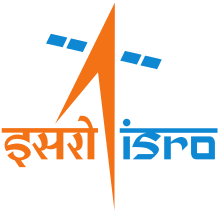PSLV-C34
PSLV-C34 was the 36th mission of the PSLV program and 14th mission of PSLV in XL configuration. The PSLV-C34 successfully carried and deployed 20 satellites in the Sun-synchronous orbit. With a launch mass of 320,000 kilograms (710,000 lb) and payload mass of 1,288 kilograms (2,840 lb), the C34 set a new record of deploying the maximum number of satellites by Indian Space Research Organisation in a single mission. The PSLV-C34 carried One Cartosat-2 satellite, SathyabamaSat (satellite from Sathyabama University, Chennai), Swayam (satellite from College of Engineering, Pune) & 17 other satellites from USA, Canada, Germany & Indonesia.[1][2][3][4][5][6]
 Model of the PSLV rocket | |
| Mission type | Deployment of 20 satellites. |
|---|---|
| Operator | ISRO |
| Website | ISRO website |
| Mission duration | 26:30 minutes |
| Distance travelled | 505 Km |
| Spacecraft properties | |
| Spacecraft | Polar Satellite Launch Vehicle |
| Spacecraft type | Launch vehicle |
| Manufacturer | ISRO |
| Launch mass | 320,000 kilograms (710,000 lb) |
| Payload mass | 1,288 kilograms (2,840 lb) |
| Start of mission | |
| Launch date | 09:26:00, 22 June 2016 (UTC) (IST) |
| Rocket | PSLV |
| Launch site | Satish Dhawan Space Centre |
| Contractor | ISRO |
| Deployment date | 22 June 2016 |
| End of mission | |
| Disposal | Placed in graveyard orbit |
| Deactivated | 22 June 2016 |
| Orbital parameters | |
| Regime | Sun-synchronous orbit |
| Payload | |
| Cartosat-2 satellite (primary) and 19 other satellites from Canada, Germany, India, Indonesia & USA. | |
| Transponders | |
| HPBW | |
| First stage | |
| Propellant mass | 211,400 kg (466,100 lb) |
| Fuel | HTPB based |
| Second stage | |
| Propellant mass | 42,000 kg (93,000 lb) |
| Fuel | Liquid UH 25 + N 2O 4 |
| Third stage | |
| Propellant mass | 7,600 kg (16,800 lb) |
| Fuel | HTPB based |
| Fourth stage | |
| Propellant mass | 2,500 kg (5,500 lb) |
| Fuel | Liquid MMH + MON-3 |
Mission parameters
- Mass:
- Total liftoff weight: 320,000 kilograms (710,000 lb)
- Payload weight: 1,288 kilograms (2,840 lb)
- Overall height: 44.4 metres (145.7 ft)
- Propellant:
- Stage 1: Solid HTPB based
- Stage 2: Liquid UH 25 + N
2O
4 - Stage 3: Solid HTPB based
- Stage 4: Liquid MMH + MON-3
- Altitude: 526.877 kilometres (327 mi)
- Maximum velocity: 7,606.61 metres per second (24,956 ft/s) (recorded at time of Cartosat-2 separation)
- Inclination: 97.48°
- Period: 26 minutes 30 seconds
Source:[7]
Launch
PSLV-C34 was launched from Satish Dhawan Space Centre at 09:26 IST on 22 June 2016. The PSLV carried total 20 satellites including the primary payload Cartosat-2C. Cartosat-2C was placed in low Earth orbit at 9:44 IST. The entire mission lasted 26 minutes and 30 seconds.[1][2][3][4][5][6] The PSLV-C34 is a more advanced, expendable version of the rocket used to launch the Indian Mars Orbiter in 2014.[8]
Mission milestones
The mission marked:
- 36th flight of Polar Satellite Launch Vehicle.
- 14th flight of Polar Satellite Launch Vehicle in XL configuration.
- Record number of satellites carried on a single flight by ISRO.
Record launch
On 28 April 2008, by placing 10 satellites on PSLV-C9 (PSLV-CA), Indian Space Research Organisation created a world record for the highest number of satellites launched in a single mission. This record was broken by NASA in 2013 (by launching 29 satellites) and was further improved by ISRO when they launched 104 satellites. PSLV-C34 launch was the biggest launch (in terms of number of satellites) by ISRO until PSLV-C37.
Payload
PSLV-C34 carried and deployed total 20 satellites. Following are the details of the payload.[7]
| Country | Name | Nos | Mass | Type | Objective |
|---|---|---|---|---|---|
| M3MSat | 1 | 85 kg | Microsatellite technology demonstration | Study of AIS from Low Earth orbit. | |
| GHGSat-D | 1 | 25.5 kg | Earth observation microsatellite | Measuring atmospheric concentration of greenhouse gases. | |
| BIROS | 1 | 130 kg | Earth observation microsatellite | Remote sensing of high-temperature events. | |
| Cartosat-2C | 1 | 727.5 kg | Earth observation satellite | Primary payload. For LIS & GIS uses. | |
| SathyabamaSat | 1 | 01.5 kg | Earth observation nanosatellite | Collect data on greenhouse gases. | |
| Swayam | 1 | 01 kg | Earth observation nanosatellite | To provide point-to-point messaging services to HAM community. | |
| LAPAN-A3 | 1 | 120 kg | Earth observation microsatellite | For land use, natural resource and environment monitoring. | |
| SkySat Gen2-1 | 1 | 110 kg | Earth observation microsatellite | Capable of capturing sub-meter resolution imagery and High-definition video. | |
| Flock-2P | 12 | 04.7 kg | Earth observation nanosatellites | Earth imaging. | |
References
- "PSLV-C34". Indian Space Research Organisation. Retrieved 22 June 2016.
- "SATHYABAMASAT". Indian Space Research Organisation. Retrieved 22 June 2016.
- "SWAYAM". Indian Space Research Organisation. Retrieved 22 June 2016.
- "India sets new record in space mission; PSLV C34 successfully injects 20 satellites into orbit". The Times of India. Retrieved 22 June 2016.
- "Big boost to India's space mission: ISRO sets record". The Economic Times. Retrieved 22 June 2016.
- "ISRO's 20-in-1 mission successful". The Hindu. Retrieved 22 June 2016.
- "PSLV-C34 brochure" (pdf). Indian Space Research Organisation website. Retrieved 22 June 2016.
- "Big money for India in space". Deccan Chronicle. 24 June 2016. Retrieved 9 July 2016.
